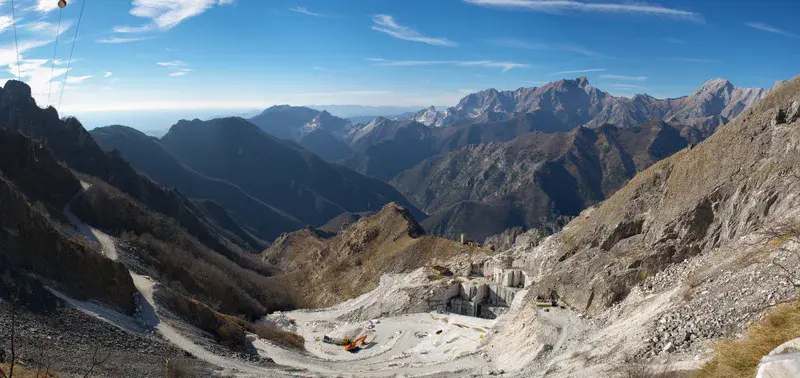
Michelangelo's Heritage (subtitle: the Cry of a Wounded Mountain)
by Mariasilvia Giamberini, National Council of Research, Pisa, Italy
The Apuan Alps are famous worldwide for the white "Carrara marble" that Michelangelo used for his famous David. The marble in this area has been extracted since the Roman period, and for centuries people in the region have made a living - and often found their death too – by working in the marble quarries in very unsafe conditions. In the last decades the demand for white marble and the ensuing extraction activities have increased, also thanks to newer machineries capable of cutting it "as if it were as soft as butter". Marble formed after the metamorphic transformation of limestone under the high pressure due to the collision - during the Oligocene - of the African and European plates, about 35 million years ago, but it was only in the Miocene, about 20 million years ago, that the "Massa Unit" was brought to the surface, due to faults, fractures and erosion processes that removed large parts of the overlying rock material, giving birth to the Apuan Alps. These mountains, overlooking the Tyrrhenian Sea, show a long historical record of the presence of humans who used their resources, but also host unique ecosystems (and a Regional Natural Park) and are an important tourist attraction. However, the presence of the quarries is becoming invasive for the landscape, for the hydrology of the area, and for the sustainable development of economic activities more respectful of the mountain environment. This also causes harsh conflicts between ecologists and owners of the quarries. Will ever the cry of these wounded mountains be listened to?
Categories
Location
- Europe (3893)
- Southern Europe (1691)
- Italy (433)
- Exact location (10.2247 E, 44.0656 N)
Tags
Colours
Image properties
12010 × 5670 px;
image/jpeg; 55.6 MB
Camera:
Nikon D800E
Software: Lightroom
Taken on 28
February
2017
Submitted on 28 February 2017
Licence
Creative Commons Attribution-NonCommercial-NoDerivs 3.0 Unported (CC BY-NC-ND 3.0)
Credit
Mariasilvia Giamberini (distributed via imaggeo.egu.eu)
Share
Appreciate
Report